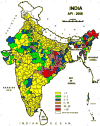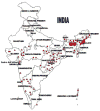Malaria in South Asia: prevalence and control
- PMID: 22248528
- PMCID: PMC3808995
- DOI: 10.1016/j.actatropica.2012.01.004
Malaria in South Asia: prevalence and control
Abstract
The "Malaria Evolution in South Asia" (MESA) program project is an International Center of Excellence for Malaria Research (ICEMR) sponsored by the US National Institutes of Health. This US-India collaborative program will study the origin of genetic diversity of malaria parasites and their selection on the Indian subcontinent. This knowledge should contribute to a better understanding of unexpected disease outbreaks and unpredictable disease presentations from Plasmodium falciparum and Plasmodium vivax infections. In this first of two reviews, we highlight malaria prevalence in India. In particular, we draw attention to variations in distribution of different human-parasites and different vectors, variation in drug resistance traits, and multiple forms of clinical presentations. Uneven malaria severity in India is often attributed to large discrepancies in health care accessibility as well as human migrations within the country and across neighboring borders. Poor access to health care goes hand in hand with poor reporting from some of the same areas, combining to possibly distort disease prevalence and death from malaria in some parts of India. Corrections are underway in the form of increased resources for disease control, greater engagement of village-level health workers for early diagnosis and treatment, and possibly new public-private partnerships activities accompanying traditional national malaria control programs in the most severely affected areas. A second accompanying review raises the possibility that, beyond uneven health care, evolutionary pressures may alter malaria parasites in ways that contribute to severe disease in India, particularly in the NE corridor of India bordering Myanmar Narayanasamy et al., 2012.
Copyright © 2012 Elsevier B.V. All rights reserved.
Figures








References
-
- Basat Q, Alonso PL. Fathoming severe Plasmodium vivax disease. Nat Med. 2011;17:48–49. - PubMed
-
- Basnyat B. Malaria-attributed death rates in India. The Lancet. 2011;377:993. - PubMed
-
- Beg MA, Khan R, Baig SM, Gulzar Z, Hussain R, Smego RA., Jr Cerebral involvement in benign tertian malaria. Am J Trop Med Hyg. 2002;67:230–232. - PubMed
-
- Breman JG. The ears of the hippopotamus: manifestations, determinants, and estimates of the malaria burden. Am J Trop Med Hyg. 2001;64:1–11. - PubMed
-
- Breman JG, Alilio MS, Mills A. Conquering the intolerable burden of malaria: what's new, what's needed: a summary. Am J Trop Med Hyg. 2004;71:1–15. - PubMed
Publication types
MeSH terms
Substances
Grants and funding
LinkOut - more resources
Full Text Sources
Medical

